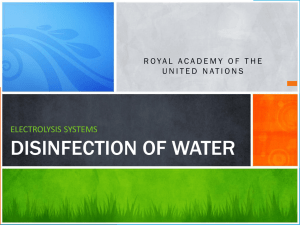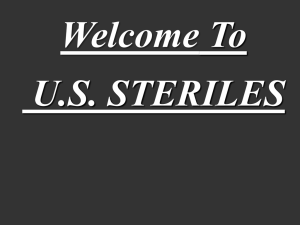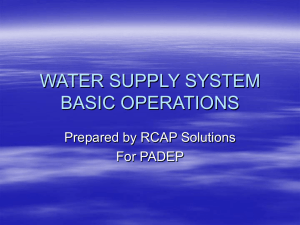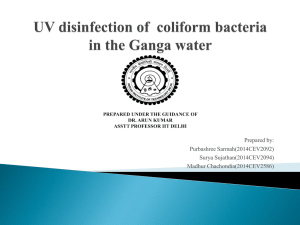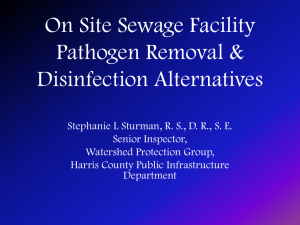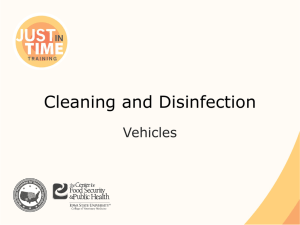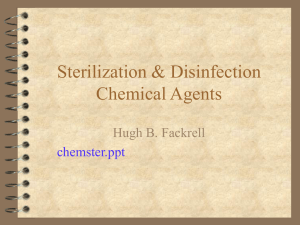Disinfection
advertisement
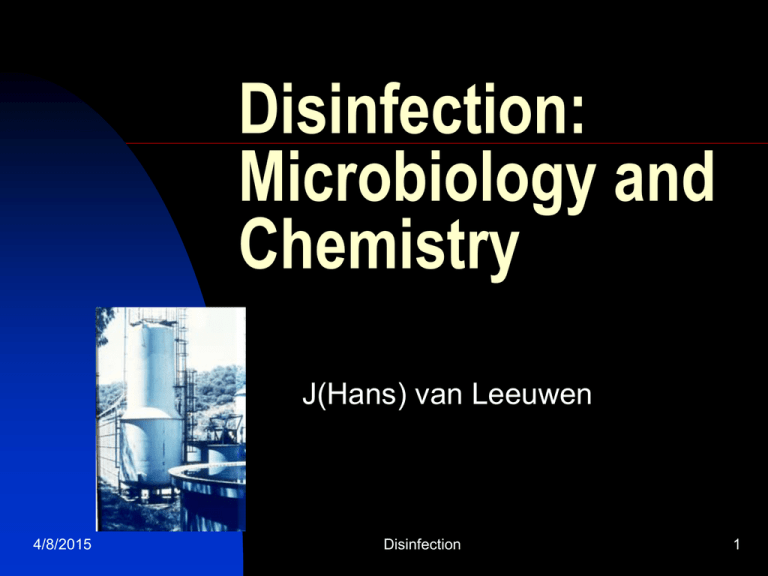
Disinfection: Microbiology and Chemistry J(Hans) van Leeuwen 4/8/2015 Disinfection 1 Introduction Need for disinfection Alternative disinfectants Disinfection kinetics Disinfectant chemistry Disinfection 2 Topics of Discussion Diseases borne by water Comparison of disinfectants The Ct concept Disinfection 3 Some common water-borne diseases prevented by disinfection Bacterial Viral Protozoan Typhoid fever Para-typhoid Bacterial diarrhea Cholera Legionnaires’ disease Hepatitis Rotavirus diarrhea Amoebiasis Giardiasis Cryptosporidiasis Disinfection 4 The rate of disinfection Like most biological processes, disinfection follows a first-order reaction with respect to the number of microbes of a certain species surviving as a function of time at a constant level of a disinfectant - dN/dt = kN, which is also known as Chick’s Law dN/N = - kdt (separating variables) ln N/No = - kt or N = No e-kt (from integration) Disinfection 5 The Ct Concept In disinfection, the ability to inactivate microorganisms is a function of both disinfectant concentration and time. Fractional removal, N/No = Cntm This is generally simplified to N/No= Ct Ct values have been determined for 99.99% virus and 99.9% Giardia removal Disinfection 6 Disinfection 7 Ozone Ct values Microorganism Ct (mg min l-1) T (oC) pH log reduction E.coli Legionella pneumophila Rotavirus 0,009 12 * 4 log 1,05 12 * 2 log 0,006-0,06 5 6-7 2 log Giardia lamblia (cysts) 0,17 25 7.2 2 log Giardia muris (cysts) 0,27 25 7 2 log Cryptosporidium parvum (oocysts) 5,39** 20 * 2 log Disinfection 8 Chlorination Disinfection 9 Chlorinator Disinfection 10 Chlorine gas flow control Disinfection 11 Chlorine contact tank with baffles Disinfection 12 Gravity fed chlorine solution feeder Disinfection 13 Gravity fed chlorine solution feeder Disinfection 14 Disinfection 15 Disinfection 16 Disinfection 17 Ultraviolet Irradiation Disinfection 18 Disinfection 19 Disinfection 20 Simple Solar Disinfection Disinfection 21 Solar Disinfection Disinfection 22 Ozonation Disinfection 23 Disinfection 24 Disinfection 25 Disinfection 26 Disinfection 27 Disinfection 28 Biomass bulking control Disinfection 29 Disinfection 30 Disinfection 31 Disinfection 32 Disinfection 33 Disinfection 34 Effect of ozonation on sludge settling Disinfection 35 Disinfection 36 Disinfection 37 Selective oxidation Disinfection 38 MeBl oxidation Disinfection 39 Effect on protozoa Disinfection 40 Ships’ Ballast Water Disinfection NUTECH O3, NOAA, NETSCO, UNCW, UWS, ISU, et al. Disinfection 41 Alien Invaders in our Coastal Waters - weirder and risky Disinfection 42 Disinfection 43 Zebra Mussel Distribution Disinfection 44 San Francisco Bay: 212 exotic species and 140 more suspected Disinfection 45 Cross section of ships showing ballast tanks and ballast water cycle Disinfection 46 Propeller exposed under Disinfection unballasted conditions 47 Into the Tonsina’s ballast tanks Disinfection 48 View of ballast tanks Disinfection from below 49 Disinfection Interconnectivity of ballast tanks in sideview 50 INSIDE THE OZONE GENERATOR ON THE TONSINA Disinfection 51 Side-stream ozone injection Disinfection 52 Ozone Reactions in Seawater 1. O3 + Br- OBr- + O2 2. 4. OBr- + O3 OBr- + O3 BrO2- + O3 2O2 + BrBrO2- + O2 BrO3- 5. H+ + OBr- HOBr 3. HOBr main contribution to total residual oxidant (TRO) Disinfection 53 TRO Decay with time Unfiltered Puget Sound TRO Decrease TRO Decrease (mg/L) 0.00 -0.40 TRO 4.0 TRO 3.0 -0.80 TRO 2.0 -1.20 -1.60 -2.00 0 50 100 150 200 Time (h) Decrease in TRO (mg/L Br2) in unfiltered Puget Sound seawater over time, Disinfection 54 starting at 2.0, 3.0 and 4.0 mg/L Br2. Data are the mean + SD of four replicates. Disinfection 55 Disinfection 56 Disinfection 57 Disinfection 58 Disinfection 59 Flowdiagram with Cyclones & UV . UV Contro l Panel To/from ballast tanks. 11.06.99 Disinfection Halvor Nilsen 60 1 Disinfection 61
